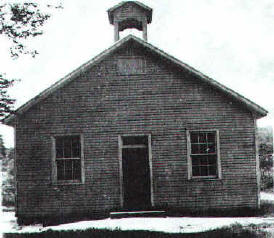In the
nineteenth century, Emmitsburg was
unique among little towns as far as
education was concerned. There were
many small schools in the area, both
public and private, and after Mount
St. Mary's College was established in
1808, a local person could get a
complete education, first grade
through college, without leaving home.
Of the 158
one-room schools in Frederick County
in 1890, well over 20 of them were
clustered in and around Emmitsburg,
which was known as the Fifth District.
About 1915,
the consolidation of schools began
under the rather erratic supervision
of the Frederick County Board of
Education, which had been established
in the middle of the 1800s.
Consolidation of tiny schools (with an
average of about 20 students) into
larger and better equipped buildings
where students could be taught in
graded classrooms was completed in the
1950s.
One-room
schools did not vanish all at once.
Even though the Emmitsburg School on
South Seton Avenue, now the Emmitsburg
Community Center, was opened in 1922,
many children still went to one-room
schools.
Harry S Hahn
of Thurmont attended Hampton Valley
School near Emmitsburg from 1928-1931.
His memories give us a good picture of
one-room schools and how they educated
children.

Hampton Valley
School was originally located near the
Emmitsburg Reservoir at Rainbow Lake
on Hampton Valley Road. When the
building fell into disrepair, it was
decided to build a new school on a
site across from Eyler's Valley
Chapel. (Building a new school was a
fairly simple project in those days,
not the multi-million dollar
undertaking it now is.)
The new school
was officially called Hampton Valley
but was, inevitably, also known as
Eyler's Valley School. There is
nothing now to mark where the school
stood. (The Chapel is still in use.)
The school site is simply a parking
lot off Hampton Valley Road, a narrow
macadam road which lies roughly
between and to the west of Emmitsburg
and Thurmont. The school enrolled
students from both districts who came
to class either on foot or on
horseback.
Mr. Hahn
remembers that a bell was rung to
begin the school day at 9 a.m.
Students listened to a scripture
reading, said a prayer, and recited
the Pledge of Allegiance. That set the
tone for the school day.
Curriculum in
the lower grades centered on 'Reading,
Writing and Arithmetic' taught
(sometimes) to the tune of a hickory
stick. Older students also
learned American history, ancient
history, and a smattering of
geography. Spelling was emphasized and
spelling bees were frequent. Older
pupils helped the younger ones. The
curriculum was the same for boys and
girls. Report cards were given out
four times a year.
One teacher
taught all seven grades. Mr. Hahn
mentioned teachers Anna Adelsberger,
Lottie Eyler, and Myrtle Troxell. Miss
Myrtle was just out of high school and
was paid $640 per year. Later she went
off to college (probably normal
school) and after that Mr. Hahn "heard
she got $800 per year."
Maryland State
and the School Board in Frederick
County grew increasingly "picky" about
how schools were run. Mr. Hahn
remembers that a county supervisor
would show up two or three times a
year to check on things, presumably to
offer helpful advice, and to be sure
teachers understood the rules and
regulations of the system.
Mr. Hahn
describes Hampton Valley School as
having a boy's coatroom and a girl's
coatroom, a boy's outhouse and a
girl's outhouse. It was heated by a
potbellied stove, and the first "old
enough" student to arrive each cold
day would start the fire. Pupils took
turns bringing water from a nearby
stream in a galvanized bucket. One
long-handled dipper served all.
Many students
attended school for six years or less.
The school year usually ran for seven
or eight months but a severe winter
snowfall could close the school down
for weeks at a time. During a school
day, the children had a fifteen-minute
recess morning and afternoon and an
hour for lunch. Youngsters brought
their lunch in a pail and sometimes
they would cross the narrow dirt road
and eat on the steps of Eyler's Valley
Chapel, which had been built in 1857.
The school day ended at 4 p.m.
Each child had
a desk with ink well set into the
upper right corner and a small drawer
under the top to keep supplies. A
dunce stool in the corner of the
classroom stood ready for the
disruptive student. One child from the
twenties remembers "if you didn't pay
attention the teacher would crack your
knuckles with a ruler."
Kids had
nothing or next to nothing in the way
of playground equipment but they all
tell, in written or oral memories, of
the good times they had with a jump
rope, a rag ball, a bat that was just
a slat of wood three or four inches
wide. They played dodge ball, hop
scotch, hide-and-go-seek. They drew a
line in the dust and ran races. On
rainy days, they would sing, play
tic-tac-toe on their slates, or
perhaps tell stories The teacher might
read to them or hold an impromptu
spelling bee.
Mr. Hahn named
classmates from the period 1928-32 as
follows: Russell Willard, Alice
Willard, Robert Warren, Paul
Alexander, Caroline Alexander, Steve
Alexander, Dan Andrew, Carrie Andrew,
Ida Andrew, Glenn Andrew, Millard
Hess, Margaret Hess, John Hahn, Rhoda
Hahn, Harry Hahn, Paul Hahn, James
Hahn, Marsha Manahan, Myrtle Manahan,
Veda Masser, Malin Masser, Chester
Masser
A Private
School Rev. Ronald Fearer has written
the following account of a private
religious school, which operated in
Emmitsburg from 1829-1870 on the
grounds of the Elias Lutheran and
Reform Church. (It should be
remembered that during this period
many "elementary schools" were called
"academy" or "seminary.")
Do you know someone who attended a One
Room School houses in the Emmitsburg
area, or have any material on old
Schools in the area?
If so, send them to us at history@emmitsburg.net
Read other stories about Emmitsburg
area schools